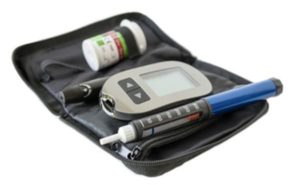Diabetes is a disease that affects a little over 34 million people in America. It is a chronic condition that continues to be a growing concern with every passing year. The more we know about this condition, the better we can reduce its impact on our lives. We’re going back to diabetes 101 and covering the basics of this condition.

Glucose, Insulin, and Cells
The fuel that powers the cells in our body is a form of sugar or glucose. Most of the glucose comes from what we consume once our body breaks it down during digestion. Most of our cells must be unlocked for the glucose to enter them. Insulin is a hormone produced in the pancreas and serves as the gatekeeper that allows the passage of glucose to the cells.
With diabetes, this process is essentially broken. It means one of two things:
- Gatekeepers have malfunctioning gate keys (Type 2 Diabetes) – The body isn’t able to use insulin properly. Type 2 diabetes includes risk factors such as being overweight and not getting enough physical activity.
- There aren’t enough gatekeepers (Type 1 Diabetes) – The pancreas does not produce enough insulin to keep up with demands or has stopped producing it altogether. In type 1 diabetes, the immune system attacks and destroys the cells in the pancreas that make insulin. Experts believe genes or environmental factors (viruses) could be responsible, though the exact cause isn’t known.
The Effects of a Broken Insulin Key
If the conversion of glucose into energy isn’t working, it builds up in the blood, raising blood sugar levels. Diabetes symptoms include:
- Extreme thirst
- Need to urinate frequently
- Lack of energy
- Weight loss
- Nausea and vomiting
- Irritability
- Blurry vision
- Slow healing of cuts and bruises
- Frequent infections
- Mood changes
Chronically high blood sugar levels can have devastating effects over time without treatment. Vision loss, kidney damage, nerve damage, and heart disease are the most common examples.
Managing Diabetes and Research
Although there is currently no cure for diabetes, it’s possible to manage it, and you can live a long and healthy life if you take care of yourself. Successfully managing diabetes means making healthier lifestyle choices, regularly monitoring your blood sugars, and following your doctor’s treatment plan.

For newly diagnosed individuals with diabetes, most treatment plans start with nutrition education, healthy weight management, and regular exercise. If blood sugars remain out of safe ranges, oral medications and injectable insulins are available.
Over the last century, advancements in technology and treatments have helped many people better manage the disease. However, the reality is that achieving optimal glucose control remains an unattainable goal for the vast majority of those with diabetes, and particularly in young people. If you have type 1 or 2 diabetes, current and future research studies may be an option. To learn more, contact Endeavor Clinical Trials at (210) 949-0807, or visit our website today!
Sources:
https://www.diabetesincontrol.com/diabetes-101/
https://www.diabetesselfmanagement.com/about-diabetes/diabetes-basics/diabetes-101/4/
https://www.eatingwell.com/article/9620/diabetes-101-essential-facts/













